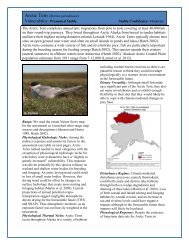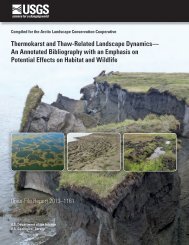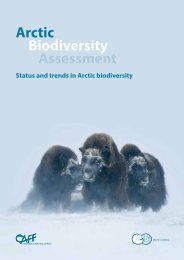Assessing Climate Change Vulnerability of Breeding Birds in Arctic ...
Assessing Climate Change Vulnerability of Breeding Birds in Arctic ...
Assessing Climate Change Vulnerability of Breeding Birds in Arctic ...
Create successful ePaper yourself
Turn your PDF publications into a flip-book with our unique Google optimized e-Paper software.
Greater White-fronted Goose (Anser albifrons)<strong>Vulnerability</strong>: Presumed StableConfidence: ModerateThe Greater White-fronted Goose, with a nearly circumpolar distribution, has the most expansiverange <strong>of</strong> any species <strong>in</strong> its genus. In Alaska, this species breeds <strong>in</strong> large numbers <strong>in</strong> both theYukon-Kuskokwim Delta and also on the <strong>Arctic</strong> Coastal Pla<strong>in</strong>, but they will also nest <strong>in</strong> the<strong>in</strong>terior. On the coastal pla<strong>in</strong> breed<strong>in</strong>g habitat ranges from lowland wet to upland dry tundra<strong>of</strong>ten near ponds or lakes (Ely and Dzub<strong>in</strong> 1994). The Greater White-fronted Goose diet isdom<strong>in</strong>ated by vegetative matter, primarily grass and sedge rhizomes, tubers, and berries (Ely andDzub<strong>in</strong> 1994). <strong>Arctic</strong> Alaskan populations w<strong>in</strong>ter on the Gulf Coastal pla<strong>in</strong> <strong>in</strong> Louisiana andTexas as well as northern Mexico (Ely and Dzub<strong>in</strong> 1994). The Alaskan <strong>Arctic</strong> Coastal Pla<strong>in</strong>population is estimated at 200,000 and population growth has been rapid <strong>in</strong> the past decade buthas recently leveled <strong>of</strong>f (Larned et al. 2012).J. Liebezeit @ WCSRange: We used the extant NatureServe map forthe assessment as it matched other range mapsources and descriptions (Johnson and Herter1989, Ely and Dzub<strong>in</strong>1994).Physiological Hydro Niche: Among the <strong>in</strong>directexposure and sensitivity factors <strong>in</strong> theassessment (see table on next page), GreaterWhite-fronted Goose ranked neutral <strong>in</strong> mostcategories with the exception <strong>of</strong> physiologicalhydrologic niche for which they were evaluatedto have a “slightly to greatly <strong>in</strong>creased”vulnerability. This response was drivenprimarily by this species reliance on waterbodies for breed<strong>in</strong>g and forag<strong>in</strong>g. A dry<strong>in</strong>g trendcould have negative impacts by reduc<strong>in</strong>gavailability <strong>of</strong> suitable habitats. Currentprojections <strong>of</strong> annual potential evapotranspirationsuggest negligible atmosphericdrivendry<strong>in</strong>g for the foreseeable future (TWSand SNAP). Thus atmospheric moisture, as anexposure factor (most <strong>in</strong>fluential on the“hydrological niche” sensitivity category), wasnot heavily weighted <strong>in</strong> the assessment.Human Response to CC: All-weather roads(necessitated by a warm<strong>in</strong>g climate andshortened ice road season) associated withenergy extraction activities could impact GreaterWhite-fronted Geese, particularly nearTeshekpuk Lake, however other sources <strong>of</strong>human activity related to climate changemitigation will be much less pervasive <strong>in</strong> thenear future so would likely only slightly <strong>in</strong>creasevulnerability.Disturbance Regime: <strong>Climate</strong>-mediateddisturbance processes, namely thermokarst,could both create and destroy forag<strong>in</strong>g andnest<strong>in</strong>g habitats through both ice wedgedegradation and dra<strong>in</strong><strong>in</strong>g <strong>of</strong> thaw lakes (Mart<strong>in</strong>et al. 2009). Likewise, predicted <strong>in</strong>creasedcoastal erosion and result<strong>in</strong>g sal<strong>in</strong>ization (Joneset al. 2009) could both negatively and positivelyaffect post-breed<strong>in</strong>g aggregations <strong>of</strong> stag<strong>in</strong>gbirds by destroy<strong>in</strong>g and creat<strong>in</strong>g forag<strong>in</strong>g /molt<strong>in</strong>g habitat.42








